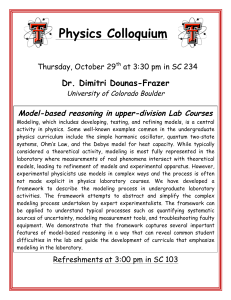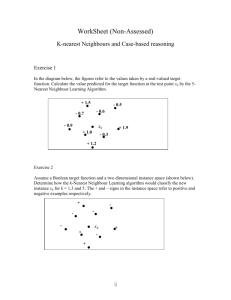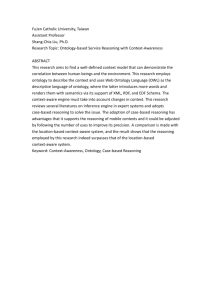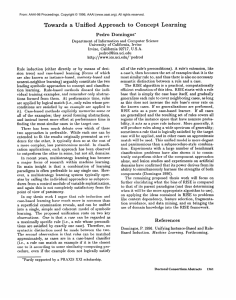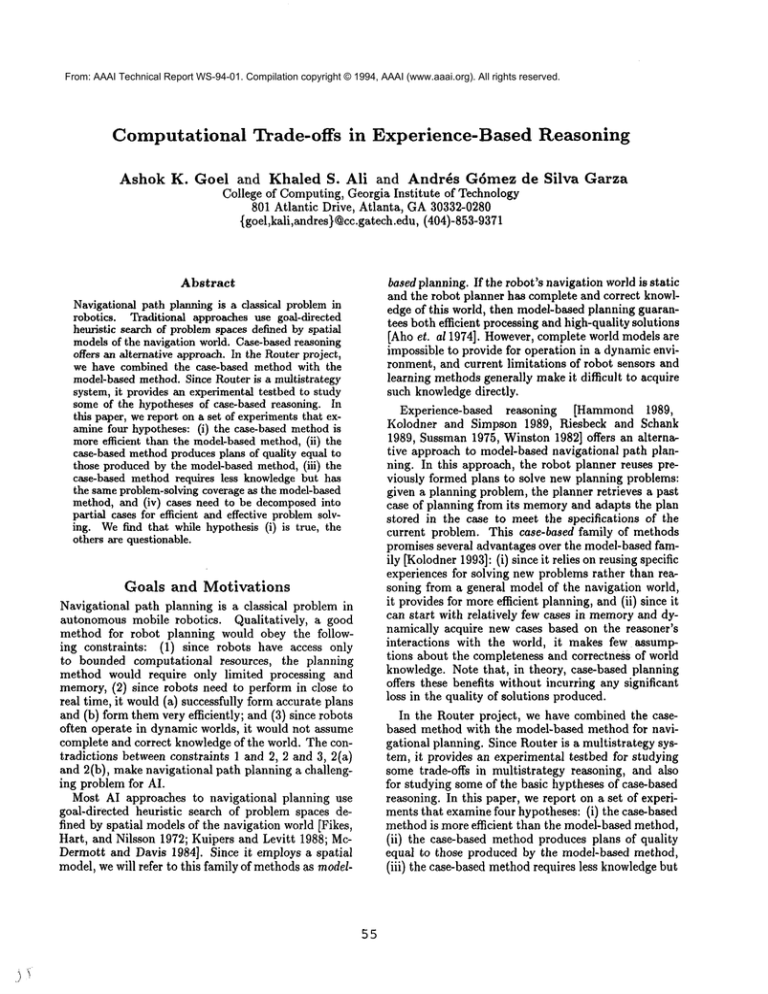
From: AAAI Technical Report WS-94-01. Compilation copyright © 1994, AAAI (www.aaai.org). All rights reserved.
Computational
Ashok
Trade-offs
in Experience-Based
Reasoning
K. Goel and Khaled S. All and Andrds Gdmez de Silva Garza
College
of Computing,
Georgia
Institute
of Technology
801Atlantic
Drive,Atlanta,
GA 30332-0280
{goel,kali,andres}
@cc.gatech.edu,
(404)-853-9371
Abstract
Navigational
pathplanning
isa classical
problem
in
robotics.
Traditional
approaches
usegoal-directed
heuristic
search
of problem
spaces
defined
byspatial
models
of thenavigation
world.
Case-based
reasoning
offers
analternative
approach.
IntheRouter
project,
we havecombined
thecase-based
methodwiththe
model-based
method.
SinceRouter
is a multistrategy
system,
it provides
an experimental
testbed
to study
someof thehypotheses
of case-based
reasoning.
In
thispaper,
wereport
ona setofexperiments
thatexaminefourhypotheses:
(i)thecase-based
method
moreefficient
thanthemodel-based
method,
(il)the
case-based
method
produces
plansof quality
equalto
thoseproduced
by themodel-based
method,
(iii)the
case-based
methodrequires
lessknowledge
buthas
thesameproblem-solving
coverage
as themodel-based
method,
and(iv)casesneedto be decomposed
into
partial
cases
forefficient
andeffective
problem
solving.We findthatwhilehypothesis
(i)is true,the
others
arequestionable.
Goals and Motivations
NavigationM path planning is a classicM problem in
autonomous mobile robotics. Qualitatively,
a good
method for robot planning would obey the following constraints:
(1) since robots have access only
to bounded computational resources, the planning
method would require only limited processing and
memory, (2) since robots need to perform in close
real time, it wouldCa) successfully form accurate plans
and (b) form them very efficiently; and (3) since robots
often operate in dynamic worlds, it would not assume
complete and correct knowledge of the world. The contradictions between constraints 1 and 2, 2 and 3, 2(a)
and 2(b), make navigational path planning a challenging problem for AI.
Most AI approaches to navigational planning use
goal-directed heuristic search of problem spaces defined by spatial models of the navigation world [Fikes,
Hart, and Nilsson 1972; Kuipers and Levitt 1988; McDermott and Davis 1984]. Since it employs a spatial
model, we will refer to this family of methodsas model-
55
basedplanning.
If therobot’s
navigation
world
is static
andtherobotplanner
hascomplete
andcorrect
knowledgeof thisworld,thenmodel-based
planning
guaranteesbothefficient
processing
andhigh-quality
solutions
[Ahoet.a11974].
However,
complete
worldmodelsare
impossible
to provide
foroperation
in a dynamic
environment,
andcurrent
limitations
of robotsensors
and
learning
methods
generally
makeit difficult
to acquire
suchknowledge
directly.
Experience-basedreasoning[Hammond1989,
Kolodnerand Simpson1989, Riesbeckand Schank
1989,Sussman
1975,Winston1982]offersan alternativeapproach
to model-based
navigational
pathplanning.In thisapproach,
therobotplanner
reusespreviously
formedplansto solvenewplanning
problems:
givena planning
problem,
theplanner
retrieves
a past
caseof planning
fromitsmemoryandadaptstheplan
storedin the caseto meetthespecifications
of the
currentproblem.
Thiscase-based
familyof methods
promises
several
advantages
overthemodel-based
family[Kolodner
1993]:
(i)since
itrelies
onreusing
specific
experiences
forsolving
newproblems
ratherthanreasoningfroma general
modelof thenavigation
world,
itprovides
formoreefficient
planning,
and(ii)since
can start with relatively few cases in memoryand dynamicMly acquire new cases based on the reasoner’s
interactions
with the world, it makes few assumptions about the completeness and correctness of world
knowledge. Note that, in theory, case-based planning
offers these benefits without incurring any significant
loss in the quality of solutions produced.
In the Router project, we have combined the casebased method with the model-based method for navigationM planning. Since Router is a multistrategy system, it provides an experimental testbed for studying
some trade-offs in multistrategy reasoning, and also
for studying some of the basic hyptheses of case-based
reasoning. In this paper, we report on a set of experiments that examine four hypotheses: (i) the case-based
method is more efficient than the model-based method,
(ii) the case-based method produces plans of quality
equal to those produced by the model-based method,
(iii) the case-based methodrequires less knowledgebut
has the same problem-solving coverage as the modelbased method, and (iv) cases need to be decomposed
into partial cases for efficient and effective problem
solving. Wefind that while hypothesis (i) is true,
the others are questionable. The goal of this paper
is to report on these experiments, draw some lessons
on the utility of the case-based and model-based methods for navigational planning, and the appropriateness
of a specific frameworkfor multistrategy reasoning.
heuristic, forms a high-level plan, and then sets up the
subtask of plan refinement to fill in lower-level details.
Router’s case-based method forms path plans by retrieving and adapting past planning cases. A case contains information about the initial and goal locations
in a planning episode, the spatial neighborhoods to
which the two locations belong, the path connecting
the two locations, and whether the plan succeeded or
failed upon execution in the world. It is indexed both
by the initial and goal locations of the stored plan and
by the neighborhoods to which the two locations belong. Given a planning problem, i.e., given the specification of the initial and goal locations in a navigation
world, the case-based method uses the problem as a
probe into its case memory. If the case memorycontains a successful case whose initial and goal locations
are the same as in the given problem, then the case
directly provides the desired plan. If the case memory
does not contain that a case that exactly matches the
given problem, but contains a successful case such that
the initial and goal locations of the case and the given
problem are in the same neighborhoods, then the case
is retrived and adapted. Case adaptation in Router
consists of appending paths to one or both ends of a
retrieved case.
General
System
Design
Router is a goal-directed multistrategy navigational
path planning system. It operates in two kinds of
navigation worlds: representations of office buildings
such as the College of Computing Building (CoC)
Georgia Tech (GT), and representations of urban areas such as the Georgia Tech campus in Atlanta. In
both worlds, the input to Router is a pair of spatial locations representing the initial and goal positions that
the path should connect. The initial and goal locations
are amongthe intersections between the pathways in
the world; the pathways are the streets in the Georgia
Tech domainand the corridors and hallways in the College of Computing domain. The output produced by
the system is an ordered set of path segments (streets,
hallways) between the initial and the goal locations.
In addition, Router accepts as input feedback on the
execution on a plan it produces and attempts to learn
from both its successes and failures.
Router combines the model-based and case-based
methods for planning navigation paths in these domains. It integrates these two methods in three dimensions: planning, memory, and learning. In the
following subsections we briefly characterize the main
components of Router in these three dimensions.
Memory Organization
As indicated above, the hierarchically-organized spatial model of the navigation world in Router serves
two purposes. First, it defines and decomposesproblem spaces for search as described above. Second, it
provides a scheme for organizing the case memory.The
planning cases are organized around the neighborhoodsubneighborhood hierarchy. Each case is indexed by
the end locations of the path it contains, which serves
as its primary index, and by the spatial neighborhoods
of the end locations, which acts as its secondary index.
In this way, the semantic and episodic knowledge in
Router’s memoryare closely linked, with the semantic knowledgein the form of the spatial model providing the indexing scheme for organizing the memoryof
planning episodes or cases.
Planning Strategies
As in traditional
robot planners, Router’s modelbased method performs a heuristic search of problem spaces defined by a spatial model of the navigation world. Unlike many traditional robot planners,
however, Router’s spatial model is only qualitative:
it contains no quantitative information such as distances between locations. Further, the spatial model
is organized in a neighborhood-subneighborhood hierarchy where a neighborhood pertains to a spatial region in the navigation world. The representation of a
neighborhood contains information about the important pathways (streets, corridors) in the neighborhood,
the directions of the pathways, the intersections between the pathways, the super- and subneighborhoods,
and the relative locations of the subneighborhoods. A
lower-level neighborhood in the hierarchy contains information about additional pathways and intersections
but in a smaller region of space than a higher-level
neighborhood. The model-based planner forms plans
by a heuristic search with top-down control: it starts
from the top-level neighborhood, uses direction as a
Multistrategy
Planning
Given a planning task (or subtask), the model-based
and the case-based methods offer alternative planning strategies. Router contains a simple introspective
strategy selector that opportunistically selects a specific strategy for a given task. Note that the task may
be the overall planning problem of a subtask set up by
the model-basedmethod(e.g., finding a top-level plan)
or by the case-based method (e.g., adapting a case).
Learning
Router performs two kinds of learning. First, it
quires and stores new cases as it forms new plans
receives reports on their execution. A new case is
tomatically indexed both by the end locations of
56
acand
authe
path it contains and by the neighborhoods of the end
locations as described above. Note that a case may
contain a successful plan or a failed one depending
on the feedback on the execution of the plan. Router
keeps both successful and failed cases as in [Hammond
1989]. Note also that once a path is known, all of its
constituent subpaths are also known, and so they too
can be stored for their potential reuse in the future.
In Router’s domain, the decomposition of a case into
sub-cases is obvious, and, if desired, the sub-cases can
easily stored along with the cases.
Second, Router uses the new cases to learn the spatial model of its navigation world. For example, given
a failed plan, it revises its world modelto reflect the
cause of the failure. In this paper, we focus only on
speed-up learning in Router.
position of cases into partial cases (at storage time) results in more efficient problem solving (on future problems). The prima facie justification for this hypothesis
is that in general storing partial cases enables the retrieval of a case more appropriate to a given problem,
and the retrieval of an appropriate case reduces the
computational cost of adapting it to meet the specifications of the problem. Testing this hypothesis raises
the issue of what is a reasonable partial case. In the domain of navigational path planning, the logical answer
is that partial cases correspond to the path segments
in a navigation plan (where, again, a path segment
is defined as the path between two consecutive street
changes).
General
Experiment
Design
In order to evaluate the many dimensions, aspects and
features of the theory behind Router, we conducted
a series of ablation experiments. [Cohen and Howe
1988]. Although Router runs on a real robot called
Stimpy, the experiments reported here were conducted
on a simulated version of the robot so as to avoid the
influence of new variables pertaining to perception and
action. This allows us to focus on the theory behind
Router.
Design of Experiment 1: The first set of experiments was designed to test two related hypotheses
regarding the computational efficiency of case-based
reasoning and multistrategy reasoning: H[l(i)] casebased reasoning is computationally more efficient than
model-based reasoning, and, hence, H[l(ii)] integrated
case-based and model-based reasoning is more efficient
than model-based reasoning.
Design of Experiment 2: The second set of experiments was designed to test two related hypotheses regarding the quality of solutions produced by case-based
reasoning and multistrategy reasoning: H[2(i)] casebased reasoning produces solutions of quality equal to
those produced by model-based reasoning, and, hence,
H[2(ii)] intergated case-based and model-based reasoning produces solutions of quality equal to those produced by model-based reasoning. Testing these hypotheses raises the issue of how to measure the quality of a solution. In the domain of navigational path
planning, the logical answer is that a shorter navigation plan is better than a longer one. However, since
Router contains no quantitative information (such as
distances between locations), the issue becomeshowto
measure the shortness of a navigation plan. Weused
the number of path segments in a navigation plan for
this purpose, where a path segment is defined as the
path between two consecutive street changes in the
overall path.
Design of Experiment 3: The third set of experiments was designed to test a hypothesis about the decomposition of cases into partial cases: H[3] the decom-
Design of Experiment 4: The fourth set of experiments was designed to test two related hypotheses about the problem-solving coverage and knowledge
requirements of case-based reasoning: H[4(i)] casebased reasoning can be bootstrapped with relatively
few cases in memory,and H[4(ii)] case-based reasoning
has the same problem-solving coverage as model-based
reasoning even though its knowledge requirements are
much smaller.
57
Router’s two domains of GT campus and CoCbuilding admit about 10000 and 1000 problems respectively.
We conducted most of the above experiments with
Router using 10 sets of 50 path planning problems
each, where the problems and their order within a
problem set were generated randomly. Since 50 problems maybe too small a numberfor testing some of the
above hypotheses, we conducted some experiments on
a larger set of 1000 problems. All experiments were
conducted on both the Georgia Tech domain and the
College of Computing domain.
In all experiments involving multistrategy reasoning, the case memorywas empty at the beginning of
the experiment, but it grew as subsequent problemsolving cases were stored in it. In the experiments involving the exclusive use of case-based reasoning, the
case memory had to be primed by adding (randomly
formed) cases to the memory before conducting the
experiments. Since we chose to generate the cases randomly, we did not make sure that there was a case
going from each neighborhood to every other neighborhood. However, since we used a random method
for generating the cases, in the runs with a large number of cases in memoryat the start, the chances of
there being a case going from a neighborhood to every
other neighborhood were high. All experiments were
conducted on a dedicated Sun workstation.
Figure1: Comparison
of average
problem
solving
timesfordifferent
strategies.
Results of Experiment 3: The data from experiment
3 shows that hypothesis HI3] is false: the deExperimental Data and Results
composition of cases into partial cases and the storResultsof Experiment1: The data from experage of partial cases increased the problem-solvingtime.
iment1 confirms
hypothesis
Hit(i)]:
it showsthat
On average, the problem-solving time for the entire
when appropriate
casescan be foundin memoryto
path-planning process, including the storage of partial
perform(pure)case-based
planning,
case-based
reapaths, was 1.7 times more than the problem-solving
soning
indeed
is moreefficient
thaneither
model-based time without storage of partial paths (see Figure 2).
planning
or multistrategy
planning
(seeFigure1).
(Because of this result, all other experiments were conaddition,
thisdatashowsthathypothesis
H[l(ii)]
ducted without storing partial cases.)
false:whenthe numberof casesin memoryis small
(notshownin thefigure),
model-based
planning
perResults of Experiment 4: The data from experformedfasterthanmultistrategy
reasoning
most(apiment 4 shows that while hypothesis H[4(i)] is true,
proximately
92%)of thetimewhilecase-based
planhypothesis H[4(ii)] is false: while the case-based planner can indeed solve someproblems with relatively few
ningtypically
fallstoproduce
a solution
atall.
initial cases in the case memory,it covers fewer probWhenwe repeated
thisexperiment
on a largerproblemsetof 1000problems,
wefoundthat,formultistrat- lems than can model-based reasoning. This data shows
that the number of problems that can be solved by the
egy reasoning,
at thebeginning
theaverageproblemcase-based planner increases linearly with the initial
solving
timeincreases
as moreproblems
aresolvedand
number of cases in memory(see Figure 3). In particmorecasesarestoredin thecasememory.
In particular, we needed to seed the case-based planner with
ular,theproblem-solving
timeincreased
by approxiapproximately 16%of all the possible problems in our
matelytwo hundredths
of a secondper problemfor
domain before it could solve approximately half (50of
thefirst1000problems.
the problems given to it.
Resultsof Experiment2: The data from experiment2 showsthatbothhypotheses
H[2(i)]
andH[2(ii)]
Theoretical
Implications
arefalse:in general,
thecase-based
methodproduced
solutions
thatwereworsethanthesolutions
produced
The main theoretical implications of this work can be
categorized along the lines of the four hypotheses we
by themodel-based
method,
and,asa result,
theinterstudied experimentally.
gatedsystem
alsoproduced
solutions
of inferior
qualProblem Coverage and Knowledge Requireity.The model-based
planneralwapsproduced
paths
ments: The result that we least expected from our
witha smaller
or equalnumberof pathsegments
than
experiments with Router is that the problem-solving
thecase-based
planner.
58
,
380
360
3,10
32O
3O0
290
26,0
24O
220
200
180
160
1,10
120
IO0
90
6O
4O
20
0
,
,
,
,
,
¯
,
,
,
,
,
,
,
,
,
,
¯
,
Ro~wi~ Stm’,lge oT Partial
7
11~NoStorage
O~Partial C__~e~_
~-.
"
"
¯
¯
I
I
I
I ~I
I
’
m
.
¯
¯
.Ilia a ~’, I
I
I
I
I
2 4 6 8 10 12 1,1. 16 18 20 22 24 26 28 50 32 34 36 ~ 40 42 44 ,,16 18 50
Path
Figure 2: Effects of partial cases.
coverage of case-based reasoning increases only linearly with the number of cases in memory. Wefully
expected that the coverage of case-based planning will
strongly depend on the number of cases in memory.
However, initially we thought that as the case-based
planner acquires new cases, the number of problems
it can successfully solve will increase very rapidly -muchmore rapidly than the number of cases available
in its memory.Clearly, this did not happen. Instead,
we found that the case-based planner needed about
16%of all possible problems in its domain before it
started working effectively in that it could solve a good
fraction of the problems given to it, and even then it
could solve only about half of all problemsgiven to it.
In general, it seems that for a domain with N elementary components and N(N-1)/2 possible problems,
is necessary to have 10*Ncases in memorybefore the
case-based planner can start working effectively.
As we argued in the introduction to this paper,
model-based methods assume complete and correct
knowledge of the world, and this assumption is not
quite valid in many situations such as navigational
path planning. However, it appears that the success
of case-based methods is similarly dependent on the
assumption that a large numberof cases is available in
memory. In fact, it seems that the problem-solving
coverage of case-based reasoning is directly proportional to the numberof available cases.
Computational
Efficiency
of Reasoning:
The
case-based method for planning appears to be computationally more efficient than the model-based method.
This is because the case-based methodreuses old plans
°
rather than forming new ones.
However, integrated case-based and model-based
planning can be computationally less efficient than either case-based or model-based planning. This appears to contradict the result reported by Veloso based
on her work on the Prodigy system [Veloso 1992].
Prodigy integrates the methods of non-linear planning
and derivational analogy. In her experiments with
Prodigy in the domainof transport (logistic) planning,
Veloso found that the combination of non-linear planning and derivational analogy was more efficient than
the method of non-linear planning alone. Webelieve
that this contradiction could be due to a number of
factors: the differences between the derivational casebased reasoning used in Prodigy and transformational
case-based reasoning used in FLouter, the differences
between the non-linear planner in Prodigy and the
model-based planner in Router, and the differences between the mechanismsfor strategy selection in the two
systems.
Quality of Solutions: In general, model-based reasoning appears to produce plans of a quality higher
than does case-based reasoning. This contradicts the
result reported by Koton based on her experiments
with the Casey system [1988]. Casey performs medical diagnosis. It contains a global causal modelof the
heart as well as past cases of diagnosing somekinds of
heart problems. It combines case-based reasoning and
model-based reasoning for solving new heart-related
problems. Koton reports that the combination of casebased and model-based reasoning produced solutions
that were as accurate as those produced by the
59
Problems
Solved
30
28
2~
24
22
2O
18
16
14
12
10
8
6
4
2
0
126
I
I
I
I
252
378
504
63O
I
Figure 3: Numberof problems solved (out of 50) with different
based path planning.
model-based method alone.
Given a diagnostic problem, Casey first uses its
model of the heart to validate the apparently relevant
cases in its memory, and then works with only the
model-validated cases. Thus the quality of its solutions
is due to its use of the model of the heart even when
it is apparently using the case-based methodfor diagnosis. Therefore, the results from Casey should not be
interpreted as implying that the use of the case-based
method alone produces solutions of equal quality to
those produced by the model-based method.
In a different version of our Router system, we have
used Router’s spatial model of its navigation world to
(i) validate the cases retrieved from its memory,and
(ii) validate the solutions produced by the case-based
method by a kind of spatial simulation. The problem
with this kind of model-basedcase validation is that it
(again) assumes that the model is complete and correct. Kritik [Goel 1991] offers an alternative approach.
It combines case-based and model-based reasoning for
designing a class of engineering devices. Instead of
using a global domain model, however, it uses casespecific device models. Its approach for integrating
case-based and model-based reasoning offers the benefit of combiningthe efficiency of ca~e-ba.sed reasoning
with the accuracy of model-based reasoning without
requiring global domain models.
Partial Cases: On the surface, the decomposition of
cases into partial cases at storage time has the potential of retrieving more appropriate cases when a new
problem is presented to the case-based planner at a
later time. In turn, the retrieval of a case that more
~
I
I
I
8~
10~
1134
amounts of memorybootstrapping for pure case-
closely matches the new problem can help to reduce the computational cost of adapting the old plan
to solve the problem. Our experiments with Router,
however, clearly demonstrate that in general the use
of partial cases significantly increases the cost of casebased reasoning. Wefully expected that the use of
partial cases will add to the cost of retrieving appropriate cases from memorybecause the memorywould
contain more cases. Our analysis of the Router experiments, however, indicates that the added cost of
retrieval is small in relation to the added cost of decomposingthe case into partial cases and storing the
partial cases in memory.
An alternative design strategy might be to decompose a case into partial cases at case-adaptation time
if so needed for problem solving. If a partial case is
extracted during the process of modifying a retrieved
case, then the partial case can be stored in the case
memorywithout incurring the additional cost of case
decomposition.
The above discussion leads us to the conclusion that
at least for navigational path planning, an integration
of case-based and model-based reasoning is the best
strategy. An integrated approach would be able to
combine the advantages of both methods in a complementary manner. In particular, such an integrated
approach would combine the efficiency of cased-based
planning and the robustness of model-based planning.
However, it seems clear from our experiments that
in order to fully exploit the advantages of the integrated approach for designing practical robot planners,
Router’s mechanismfor strategy selection would need
6O
to be smarter.
References
A. Aho, J. Hopcroft, and J. Ullman. The Design and
Analysis o] Computer Algorithms. Addison-Wesley.
1974.
P. Cohen and A. Howe. How Evaluation Guides Research. AI Magazine, 9(4):35-43. Winter 1988.
R. Fikes, P. Hart, and N. Nilsson. Learning and Executing Generalized Robot Plans. Artificial Intelligence, 3:251-288. 1972.
A. Goel. A Model-Based Approach to Case Adaptation. Proceedings o] the Thirteenth Annual Conference of the Cognitive Science Society, 143-148.
Lawrence Erlbaum Associates. 1991.
K. Hammond.Case-Based Planning: Viewing Planning as a MemoryTask. Academic Press. 1989.
J. Kolodner. Case-Based Reasoning. Morgan Kaufmann Publishers. 1993.
J. Kolodner and R. Simpson. The MEDIATOR:
Analysis of an Early Case-Based Problem Solver. Cognitive
Science, 13, 507-549. 1989.
P. Koton. Using Experience in Learning and Problem
Solving. PhD. Dissertation, Dept. of Computer Science, MIT, 1988.
B. Kuipers and T. Levitt. Navigation and Mapping
in Large-Scale Space. AI Magazine, 9(2):25-43. 1988.
D. McDermott and E. Davis. Planning Routes
through Uncertain Territory. Artificial Intelligence,
22, 107-156. 1984.
C. Riesbeck and R. Schank. Inside Case-Based Reasoning. Lawrence Erlbaum Associates. 1989.
E. Stroulia and A. Goel. Functional Representation
and Reasoning for Reflective Systems. Applied Artificial Intelligence. To appear. 1994.
G. Sussman. A Computer Model of Skill Acquisition.
American Elsevier. 1975.
M. Veloso. Learning by Analogical Reasoning in General Problem Solving. Ph.D. Dissertation. CarnegieMellon University. 1992.
P. Winston. Learning NewPrinciples from Precedents
and Exercises. Artificial Intelligence, 19(3) 321-350.
1982.
61

